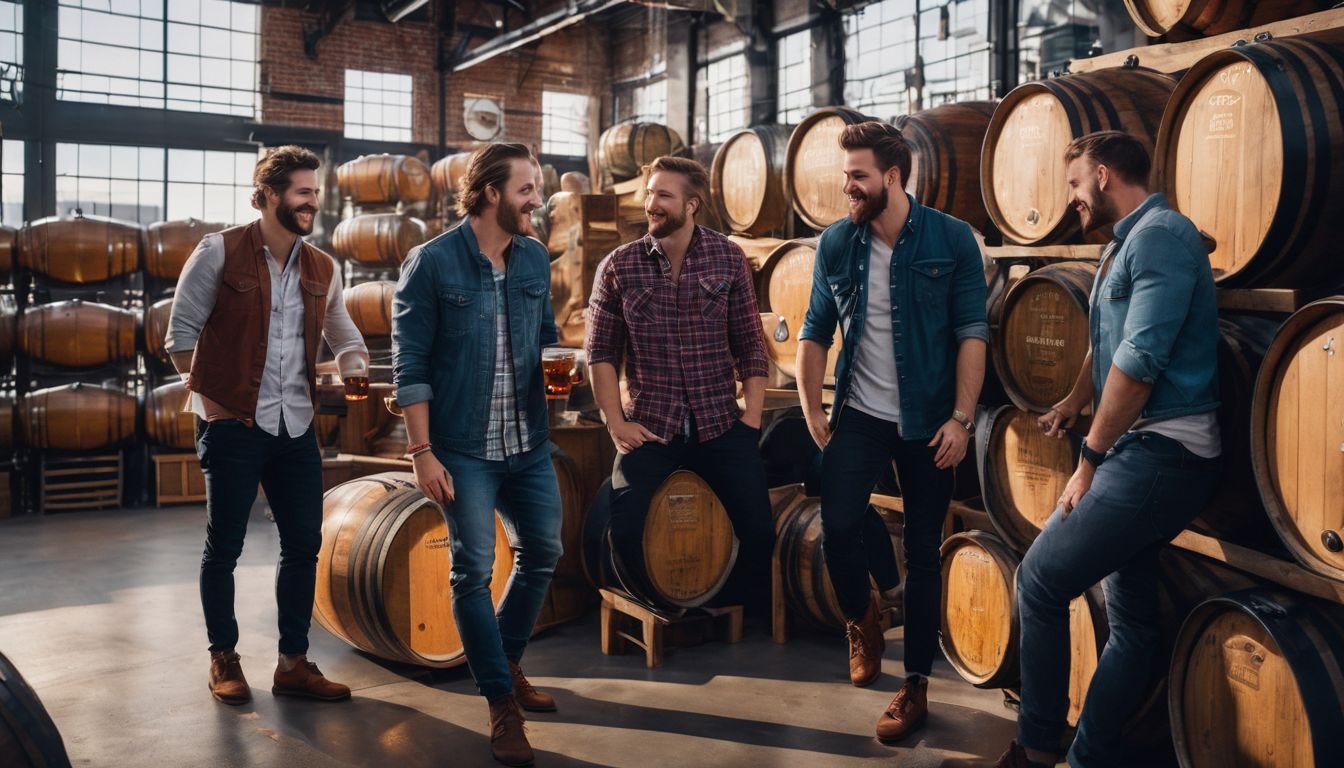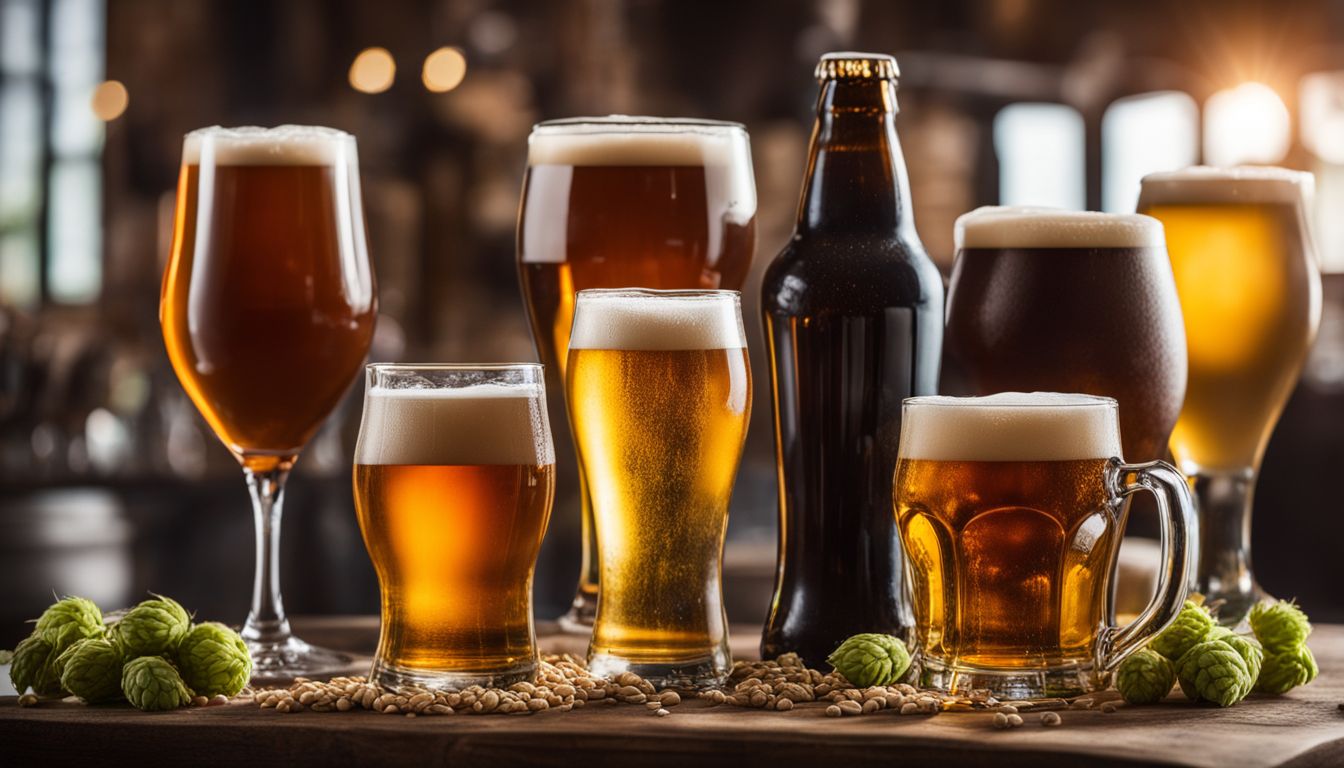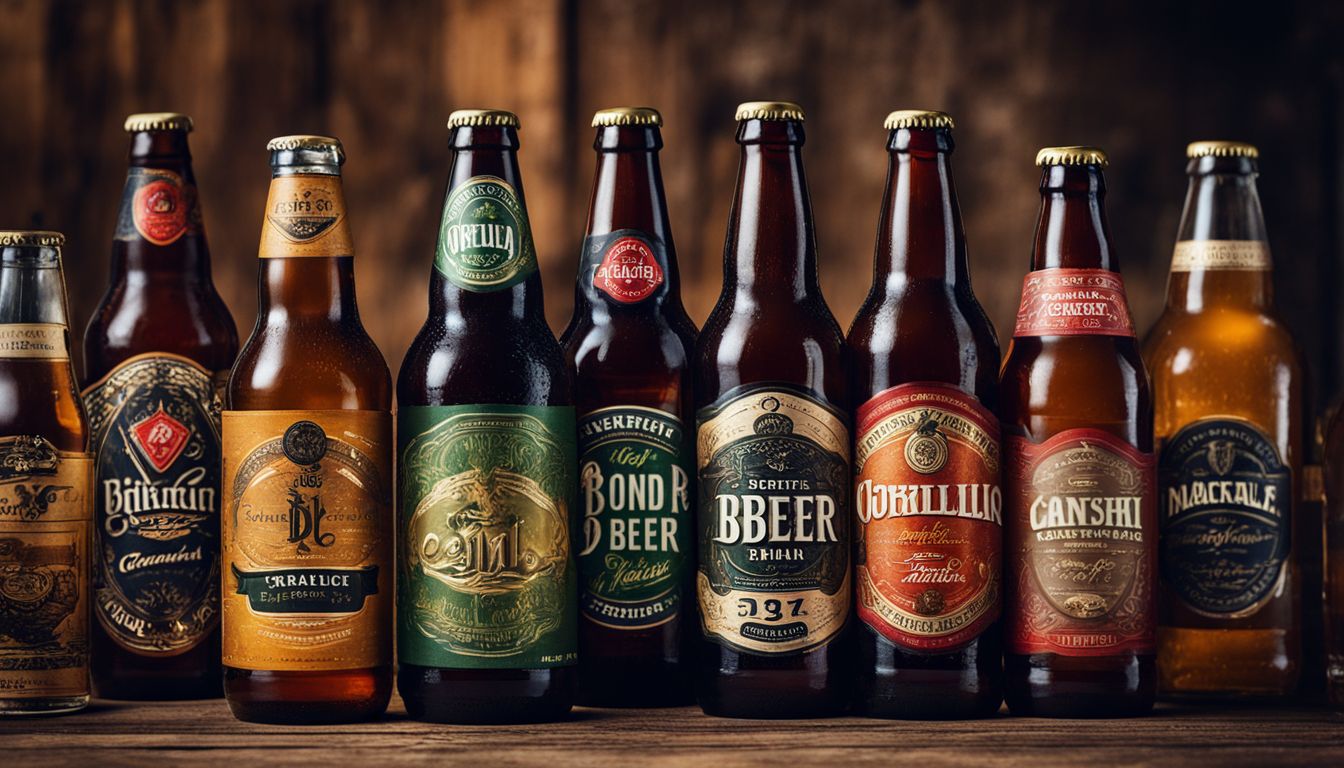Navigating the dynamic landscape of beer brands and breweries can seem overwhelming, even to passionate beer enthusiasts. Did you know that a few super-brands like Budweiser and Heineken currently dominate the global marketplace? This comprehensive guide cuts through the froth, offering a deep dive into the history of these popular brands, their brewing processes, and why they’re sought after today.
Ready for a tasty trip down Beer Lane? Keep reading!
Key Takeaways
- Budweiser and Heineken are dominant global beer brands, but there is also a rise in microbreweries offering unique craft beers.
- Craft beer is brewed by small independent breweries using traditional methods and high-quality ingredients, resulting in more flavorful and diverse options compared to mass-produced macro beers.
- The brewing process involves key ingredients like water, malted barley, hops, yeast, and other grains or adjuncts. Different styles of beer are created through specific steps like malting, mashing, boiling, fermentation, maturation, carbonation, and packaging.
- Popular beer styles include lager, IPA (India Pale Ale), stout, wheat beer pilsner Belgian tripel porter sour among others that offer distinct flavors and characteristics.
The History of the Beer Industry

Mergers and acquisitions have shaped the beer industry, while microbreweries have also emerged as a significant force.
Mergers and acquisitions in the beer industry

Big beer names have often joined forces. They do this to grow bigger and reach more people. For example, Budweiser is now part of a big group called AB InBev. This group also has brands like Corona and Stella Artois.
These mergers help them control a large piece of the beer market. Some people worry that this can make it hard for smaller breweries to compete. Yet, many small brewers still find ways to make their beers stand out and be loved by drinkers.
The rise of microbreweries

Microbreweries have been on the rise in recent years, offering beer enthusiasts a unique and flavorful experience. These small-scale breweries focus on producing limited quantities of high-quality craft beer using traditional brewing methods.
Unlike large commercial breweries, microbreweries often experiment with different ingredients and flavors to create their signature brews. This has led to an explosion of creativity in the beer industry, offering consumers a wide range of options beyond the typical mass-produced beers found on supermarket shelves.
With their dedication to quality and innovation, microbreweries have become an important part of the craft beer movement and are reshaping the way people think about and enjoy beer.
Popular Beer Brands and Trademarks
 Popular beer brands and trademarks play a significant role in the beer industry. Some of the well-known global brands include Brahma, Budweiser, Coors Light, Heineken, and Tsingtao.
Popular beer brands and trademarks play a significant role in the beer industry. Some of the well-known global brands include Brahma, Budweiser, Coors Light, Heineken, and Tsingtao.
These super-brands have established themselves as leaders in the marketplace and are widely recognized by consumers worldwide. Their logos and trademarks have become synonymous with quality and taste.
In addition to these major brands, there are also many local and independent breweries that produce unique and artisanal beers. These breweries often have their own trademarks that reflect their individual styles and flavors.
Whether you prefer a familiar global brand or enjoy exploring new local brews, the variety of popular beer brands and trademarks offers something for every beer drinker’s taste preferences.
The Craft Beer Movement

Craft beer, which is defined as a independently brewed beer made in small quantities using traditional brewing methods, has seen significant growth and popularity in recent years.
Definition of craft beer

Craft beer is a type of beer that is brewed using traditional methods and quality ingredients. It is usually made by small, independent breweries that prioritize taste and craftsmanship over mass production.
Craft breweries focus on creating unique flavors and experimenting with different styles, offering beer enthusiasts a wide range of options to explore. Unlike macro beers produced by large commercial breweries, craft beer is often considered more flavorful and diverse in its offerings.
The craft beer movement has seen significant growth in recent years, attracting a dedicated community of beer lovers who appreciate the artistry and creativity behind each pint.
Craft beer vs. macro beer

Craft beer and macro beer may seem similar but they are indeed different in various ways. These differences can be seen in their production process, taste, quality, and consumers’ preferences. The table below provides a detailed comparison between these two.
| Aspect | Craft Beer | Macro Beer |
|---|---|---|
| Production | Craft beer brewing is a complex process that involves a focus on quality ingredients and traditional methods. | Macro beer brewing involves streamlined and large-scale processes, often using cheaper ingredients. |
| Taste | Craft beers offer a wide range of taste profiles, from strong and bitter to light and fruity. | Macro beers often have a uniform and simplistic taste, often leaning towards lighter and less complex flavours. |
| Quality | Due to the focus on quality ingredients and traditional brewing processes, craft beers are often regarded as high quality. | The quality of macro beers can vary, but they are typically designed for mass consumption rather than discerning palates. |
| Consumers’ Preferences | Craft beers are preferred by consumers who appreciate diverse flavours and are willing to pay more for quality and uniqueness. | Macro beers are preferred by consumers wanting a reliable and typically affordable go-to beer. |
The growth of the craft beer market

Craft beer has experienced significant growth in recent years, capturing the attention of beer drinkers around the world. Unlike mass-produced beers, craft beer is brewed by independent breweries using traditional methods and high-quality ingredients.
This focus on craftsmanship and unique flavors has led to a surge in popularity among consumers looking for something different from their usual drink choices. In fact, craft beer now represents a substantial portion of the overall beer market, with dedicated craft breweries popping up in many cities and towns.
With its wide variety of styles and tastes, the craft beer market continues to expand, providing beer enthusiasts with an ever-growing selection to enjoy.
The Brewing Process

Discover the fascinating ingredients, step-by-step process, and diverse beer styles that make brewing a true art form.
Ingredients used in brewing beer

Beer is made using a few key ingredients. These ingredients play an important role in the taste and overall quality of the beer. Here are the main ingredients used in brewing beer:
- Water: The primary ingredient in beer, water makes up the majority of its composition. Different sources of water can affect the flavor and character of the beer.
- Malted Barley: Barley is soaked in water and allowed to germinate before being dried and crushed into malt. It provides fermentable sugars that yeast can convert into alcohol during fermentation.
- Hops: These are flowers that add bitterness, aroma, and flavor to beer. Hops balance out the sweetness from the malt and act as a natural preservative.
- Yeast: Yeast is responsible for fermentation, converting sugar into alcohol and carbon dioxide. It also contributes to the flavors and aromas in beer, depending on the strain used.
- Other Grains: Some beers may use other grains such as wheat, oats, or rye to add different flavors or enhance mouthfeel.
- Adjuncts: Adjuncts are additional ingredients that can be added to vary the flavor of the beer. Common examples include corn, rice, fruits, spices, or even coffee and chocolate.
The brewing process explained

Beer is made through a unique and complex process. Here’s how it’s done:
- Raw materials: Beer is made using water, grains (such as barley), hops, and yeast.
- Malting: The grains are soaked in water and then allowed to germinate. This process converts starches into fermentable sugars.
- Mashing: The malted grains are crushed and mixed with hot water to release more sugars. This creates a sweet liquid called wort.
- Boiling: The wort is boiled and hops are added for bitterness and flavor. Hops also act as a natural preservative.
- Fermentation: The boiled wort is cooled down and yeast is added. Yeast consumes the sugars in the wort, converting them into alcohol and carbon dioxide.
- Maturation: After fermentation, the beer is left to mature for a specific period of time to develop its flavors.
- Carbonation: Some beers undergo secondary fermentation to add carbonation, while others are carbonated during packaging.
- Packaging: Once the beer has matured and carbonated, it is packaged into bottles, cans, or kegs for distribution and consumption.
Different beer styles

Beer comes in many different styles, each with its own unique characteristics and flavors. Here are some of the most popular beer styles to explore:
- Lager: A light and crisp beer with a smooth finish. Examples include Budweiser, Heineken, and Stella Artois.
- IPA (India Pale Ale): Known for its hoppy bitterness and citrusy aroma. Examples include Sierra Nevada Pale Ale, Dogfish Head 60 Minute IPA, and Stone IPA.
- Stout: A dark and rich beer with flavors of roasted malt, chocolate, and coffee. Examples include Guinness, Samuel Smith’s Oatmeal Stout, and Founders Breakfast Stout.
- Wheat: Brewed with a significant amount of wheat malt, resulting in a light and refreshing taste. Examples include Blue Moon Belgian White, Weihenstephaner Hefeweissbier, and Hoegaarden.
- Pilsner: A golden-colored beer with a clean and crisp flavor profile. Examples include Pilsner Urquell, Bitburger Pilsner, and Becks.
- Amber/Red Ale: Known for its reddish-brown color and balanced flavors of maltiness and hoppiness. Examples include Fat Tire Amber Ale, Killian’s Irish Red Ale, and Alaskan Amber.
- Pale Ale: A hop-forward beer with a slightly bitter taste and fruity or floral aromas. Examples include Sierra Nevada Pale Ale, Deschutes Fresh Squeezed IPA, and Lagunitas IPA.
- Belgian Tripel: A strong ale with complex flavors of fruitiness, spiciness, and sweetness. Examples include Chimay Tripel, Westmalle Tripel, and La Fin Du Monde.
- Porter: Similar to stouts but usually less intense in flavor intensity with notes of chocolate or coffee-like bitterness without the roasted coffee taste found in stouts.
- Sour: Known for its tart and acidic taste, often with fruity or funky flavors. Examples include Rodenbach Grand Cru, Cascade Brewing Kriek, and Jester King El Cedro.
Beer Community and Events

Beer community and events play a significant role in the beer culture. Beer enthusiasts from all over come together to share their love for this beverage. There are various beer festivals and tasting events held around the world where people can try different types of beers and discover new flavors.
These events provide an opportunity for breweries, both big and small, to showcase their products and connect with consumers directly.
One well-known event is the Great American Beer Festival, which takes place annually in Denver, Colorado. This festival attracts thousands of beer lovers who gather to sample beers from hundreds of breweries across the United States.
It’s a celebration of craft brewing and a chance for brewers to compete for awards in different categories.
Another popular event is Oktoberfest in Munich, Germany. This legendary festival brings together millions of visitors who enjoy traditional German beer, food, music, and festivities.
It’s an iconic celebration that showcases Bavarian culture while also highlighting some of the best German breweries.
Apart from these large-scale events, many local communities organize beer tastings or brewery tours where enthusiasts can learn about different styles of beer and meet fellow fans.
These smaller gatherings create a sense of camaraderie among craft beer lovers while supporting local businesses.
In conclusion,
The global rise of popular beer brands and breweries has given birth to a vibrant beer community with various events happening worldwide throughout the year. From grand festivals like Oktoberfest to local tastings organized by passionate individuals, these events bring people together to celebrate their shared love for this beloved beverage.
Conclusion

In conclusion, the rise of popular beer brands and breweries has had a significant impact on the global beer industry. Craft breweries have brought diversity and unique flavors to the market, challenging traditional macrobreweries.
With a wide range of beer styles and a growing community of beer enthusiasts, the popularity of craft beer continues to grow. The comprehensive guide provides valuable information about the history, brewing process, and various types of beer that can enhance your understanding and appreciation for this beloved beverage.
FAQs
1. What makes a beer brand popular?
A beer brand becomes popular based on factors such as taste, quality, branding, marketing, and customer preferences.
2. How are breweries different from beer brands?
Breweries are the places where beer is made while beer brands refer to the names and logos associated with specific beers in the market.
3. Can I visit popular breweries for tours or tastings?
Yes, many popular breweries offer tours and tastings for visitors to learn about their brewing process and sample different beers.
4. Do all popular beer brands have a long history?
Not necessarily, some popular beer brands may have a long history while others may have gained popularity more recently through innovative recipes or marketing strategies.
